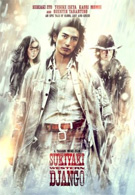Sukiyaki Western Django is a film that happens to you, not with you. If you look deeply you will find some logic and some character motivation. But, for the most part, it just stands there and looks pretty. It might look stunning, but it is extremely uneven. Sukiyaki Western Django is the perfect example of sound and fury signifying nothing. The film takes place in a parallel universe in the American west, where there are only Japanese people. Two warring posses, the reds and the whites, roam the rural areas looking for gold. They go to each town that has a legend of gold and lay waste, fighting with one another along the way. A gun-slinging stranger comes into the town that the two posses are inhabiting and exacerbates the gang on gang violence.
Quentin Tarantino pops in for a cameo in the opening scene. He comes bearing the most ridiculous southern accent. It is so fake that its not even endearing. Can someone please tell this man that he can not act? Tarantino’s cameo feels like a publicity stunt from the director, Takashi Miike, although, there are a lot of bad accents and questionable acting in the film, so maybe its the fault of the casting director?
Why the film is in English is beyond me. It is obvious that none of the actors can speak English, and so they sound like bullfrogs twisting the dialogue of the script out of their mouths. They emphasize all the wrong words and mangle their intended Western drawls in a way that iis wildly distracting. Maybe Miike was attempting to reach a broader audience by using English, but even that seems like a bad excuse to force actors to speak outside of their native tongues.
If you find beauty in violence, than this film will seem like a long poem to you - a long, twisty poem that doesn’t make a lick of sense, but a poem, nonetheless. The theme of the sets is a classic western gold mining town with a touch of Japanese temple, and they are flawless. The costumes for the reds and the whites are ornate, unexpected and fantastical. Although, at first, you’ll feel like their outfits are intended for drag queens, you’ll get used to the flashy western garb. The film has the feel of a great achievement in interior decorating. Every detail of every costume, every hairstyle, and every set is arranged perfectly.
The scenes of violence are frequent, quick and bloody. Although there are no mixed martial arts, there is plenty of gunplay and hand to hand combat to satisfy the violence-hungry. There is one character that wields a sword, but, alas, he brings it to a gunfight and gets shot. He never really gets to use his sword, other than to make inter-gang threats. The scene in which he does use his sword in the gunfight is breathtaking. He slices through the bullets as he approaches the gunslinger, and they clash gun and sword as if they were sword-fighting. Also, there is a female character who emerges in the second half of the film as “The Bloody Benten,” a woman who has “eight arms when she’s on the war path.” Her gunplay is super hot and beautifully shot.
There are two portions of the film where the violence reaches a louder pitch and the editing comes together, turning the film into quite a ride. But, most of the film is too slow and too much about setting up the violence to be enjoyable as anything other than a B-movie. It seems that Miike was attempting to make a spaghetti western from the materials of Japanese harajuku girls. It is a fun endeavor, but it feels like kitsch the whole way through. It is too easy to laugh at the fake accents and too easy to get confused by the lack of logical character motivation. Sukiyaki Western Django sounds fake, looks fake, and therefore feels fake. Watch it if you want to see some clever fight scenes, but realize that this film is just a flashy recount of a classic genre of film. The disc includes six deleted scenes, a making of featurette, two trailers and a set of clips from the film. The six deleted scenes are all extremely short and feel like unnecessary landscape shots. The first is of the sheriff saying one line: “Why don’t you take a dump and have a think?” The fifth is a clip of the whites cutting one of their own’s balls off. The other four are about as short as the first, only less interesting. The scenes are not split into a menu option screen, but instead play straight through when you click on “deleted scenes.” It is a little disorienting, but the entire process takes all of about five minutes.
The making of featurette is quite impressive. It is about a half an hour long and goes through each actor’s role in the film in great detail. It gives you a sense of just how foreign this film is. The voice over is in Japanese. Every time Miike yells “cut,” he yells it in Japanese and all of the interviews are in Japanese. There is one portion of the featurette in which Miike talks about why Sukiyaki Western Django was filmed in English. He says, “It would be strange [to have filmed the movie in ancient Japanese]. It would be like a Samurai film with western gunmen in it.” He straight out denies that he used English as a marketing tactic. I’m still not sure I believe him.
Your Daily Blend of Entertainment News
I learned a few things from the featurette: 1) The film is actually set in ancient Japan, but the town is called “Nevada;” it is not the old west. 2) None of the actors spoke English, even bilingually. 3) Many of the actors did their own stunts. 4) Japanese people drink out of grown up juice boxes. I also learned that the narrator of this featurette thinks that this film has the possibility of being the “best film in Japanese film history.” How old is Japan, again? Old, right? Clearly a lot of thought and energy went into this making of mini-documentary, but it is just boring. I don’t need to know how they trained the donkey to carry a load. I need to know what they used to blow stuff up. Rather than the secrets of the action, this was just too much of the actors’ perspectives.
Two trailers are included on the disc. The only real purpose they serve is to remind me how excited I had been about seeing this film. Both previews refer to the film as “Tashiki Miike’s English language masterpiece," but the way the action is spliced together in these trailers is so appealing that it made me want to see the film all over again, just to make sure it is still bad. Tarantino’s role is highlighted in both previews, even though he is only in the movie for about ten minutes, max. Under the “trailers” section there is also a cluster of clips. They are all in the film, but served as viral hype on the internet before it was released in the states. Again, as I watched these clips, I became irrationally excited for the release of the film. The fight scenes look so damn good on their own!
The disc is not necessarily full of special features, but it is enough to give you an idea of what went into the making of this film. This film was a difficult venture for all involved. People had to learn how to ride horses, speak lines in a foreign language and spin their gun on their finger. It is sad, really. This movie was supposed to bring Japanese cinema back to the forefront of the world’s consciousness. It was supposed to be the one.

